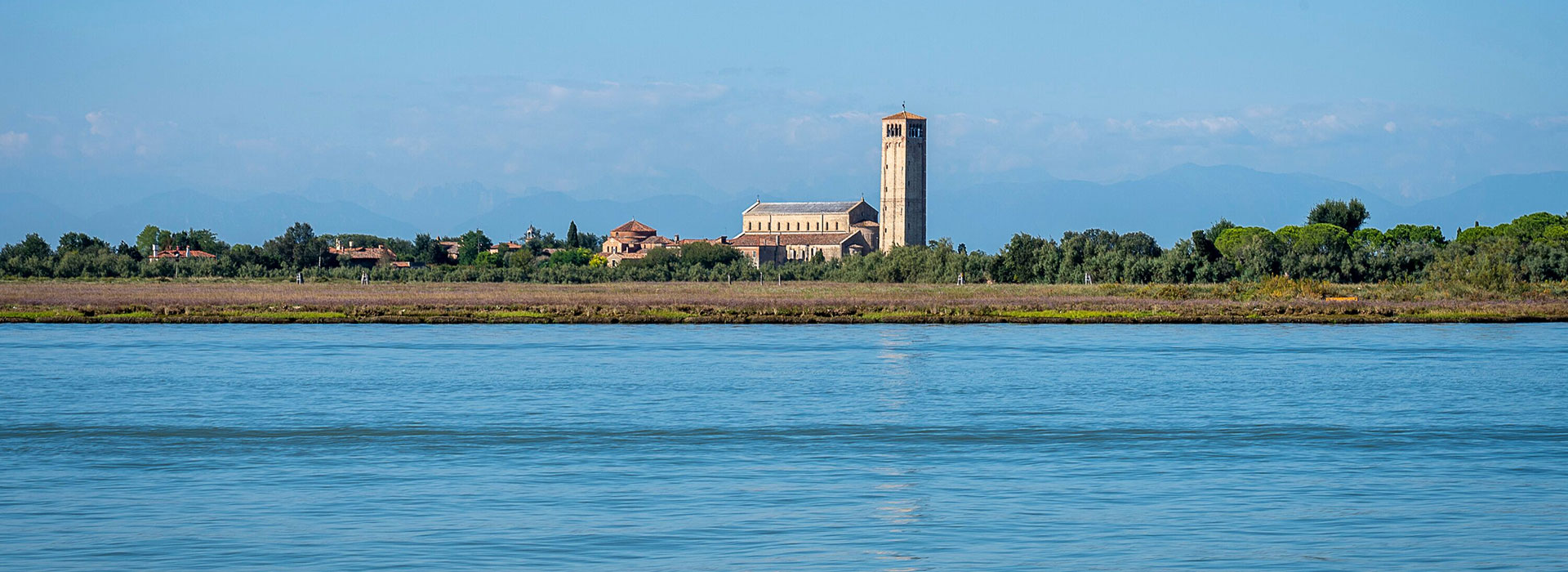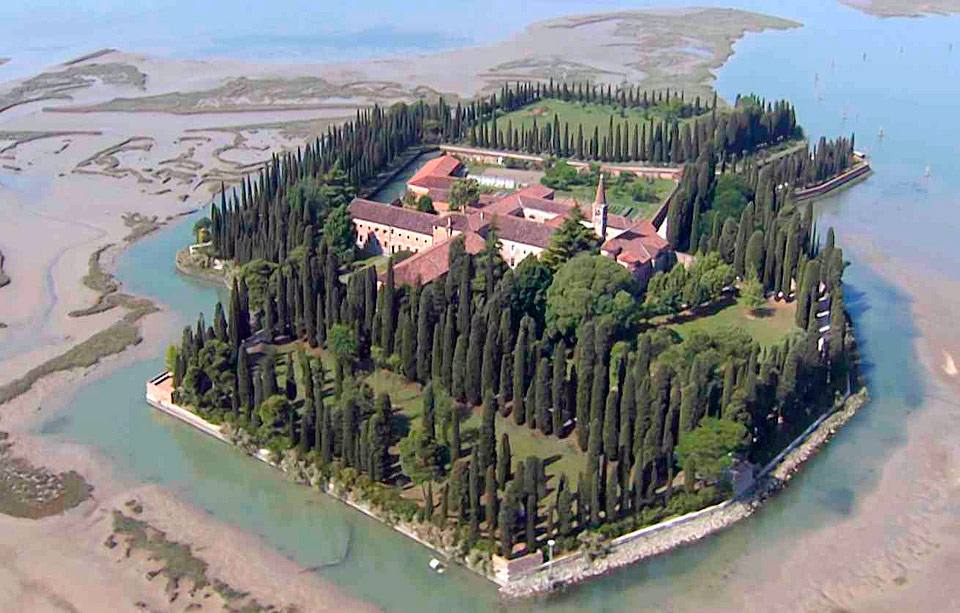The San Francesco del Deserto Island was occupied in 1200 by a community of Franciscan friars who still live inside an austere convent embellished by two XIV and XV century cloisters.
The island is very ancient. Traces which have emerged from the subsoil reveal it was frequented by the Romans, and there are finds from the lst, 4th, and 5th Centuries A.D.. The name is of popular origin and goes back to the first half of the 15th Century, when the island was abandoned for more than twenty years because of the insalubrious state of the lagoon. The Franciscan story begins in 1220: St. Francis landed there with an anonymous companion on his return from the East and was greeted by the joyful singing of the swallows (the account of the prodigy is narrated by St. Bonaventura in the Legenda Maior). In March 1223 the island was donated to the Order by Jacopo Michiel, who belonged to the doge's branch of the family and was nephew, on his wife's side, to the patriarch of Grado, Angelo Barozzi: at the time of the donation two churches were in existence, of which one was dedicated to the Saint. During the Austrian rule of Venice the island, abandoned due to its unhealthy characteristics, was used a powder depot. In 1858 it was donated to the diocese of Venice, who allowed the friars to refound a convent here.
The island can be reached both from Venice and Burano in 20 minutes by boat.
Opening Hours
For visitors:
- Opening hours 9.00-11.00 / 15.00-17.00 closed monday.
- Visits are with a Franciscan guide.
- Free offerings are welcome.
San Francesco del Deserto Visit
The first cloister
The first cloister goes back to the 13th Century. The ancient flooring in altinelle is atadepth of 35/50 cm, well-preserved on all four sides. Originally the roof was supported by coupled mullions. After being demolished during the Napoleonic invasion, the cloister was rebuilt after the return of the friars in the second half of the last century. The well in the centre, dating from the first half of the 15th Century, is known as St. Bernardino's because, by making the sign of the cross, the Sienese saint is reported to have made the water in the cistern drinkable again after it had become polluted by a brackish water stratum. The two buildings overlooking the right and left side (for those looking from the entrance to the convent) were built in the second half of the 15th and 13th Centuries respectively. The building on the right was used for guest rooms and is now the friars' quarters; the one on the left corresponds to the ancient wing of the convent and was radically restructured in the first half of the 15th Century through the munificence of Fran gola Giustinian, a Venetian nobleman (the Gothic portaI is from the 14th Century and led to the chapter house, now the sacristy).
Second cloister
The second cloister dates from the second half of the 5th Century and is the work of Fra Nicolò Erizzo, who directed the convent from 1451 to 1460. Built behind the ancient 13th Century wing, it houses the refectory and the workshops on the ground floor and the library and the friars' cells on the first floor. The puteal is flamboyant Gothic (the diamond-shaped) motif, also present in the church in the capitals of thearch of triumph and in the cornice at the base of the cupola, is important because it shows that the inspiration for both, if not their actual realisation, dates from the same time).
Church of the Stigmata
The church has one nave and its uncovered trussed roof was built in 1401 through the munificence of Frangola Giustinian. It incorporates the remains of the 13th Century church in the subsoil, which was built in its turn on a tworoomed building. The 13th Century remains are partially visible through the special grates. The architectural layout of the presbytery dates from the second half of the 15th Century. However, only the arch of triumph, the apse and the cupola are from the 15th Century (the latter two were almost entirely demolished in the 17th Century before being restored in 1961 -1963). The building's size, on the other hand, goes back to the 13th Century: during St. Francis life the presbytery area was an open space (sub diu), bordered on the right by the bell tower and on the left by the habitacle known as the oratory of St. Francis. After the Saint was canonised in 1228 the space was closed and structured as a chapel. Along with the two side walls which predate it, remains of the chapel can be seen in the architrave impost of the roof, the altar base in altinelle and some parts of the end wall, also in altinelle, which was demolished in the second half of the l5th Century in order to make room for the apse. In the 17th Century the following alterations were made to the church: in 1609 the upper part of the facade was demolished and rebuilt and the roof extended by a truss, in order to add the friars'hanging chancel on the inside and the portico on the outside. In 1629 with the hanging chancel deemed unfit and the apse and cupola being almost entirely demolished, a second chancel was erected at the back of the presbytery (the remains of this structure, which was demolished in the twenties, are visible from the outside at the back ofthe church).
Chapel of the Madonna
This was erected in the second half of the 15th Century on the remains of a small, ancient church -which, together with the bell tower, already existed before the arrival of the Franciscans. The chapel ended in a rectilinear wall. (Some remains are visible at a depth of 67 cm. through the special grates). At the end of the 15th and the beginning of the 16th Centuries the presbytery was completely restructured and the wall was demolished. The apse, cupola, arch of triumph and marble friezes are Longobardic.
Oratory of S. Francesco
The habitacle ab antiquo is know as the oratory of St. Francis because it is in some way connected to the memory of the saint. Access to it was originally on the side of the church nave. After St. Francis death, it was blocked with the stele. This was removed from the nave in 1499 during the work carried out in the second half of the 15th Century and was placed in the oratory in 1963 where it has remained placed against the side wall on the left of the entrance.
Chapel of S. Bernardino (now of S. Antonio)
Built by the Lando family in the second half of the 15th Century in honour of the Sienese saint, lt was subsequently donated to the friars by the family' descendants. The wooden crucifix is from the late 16th Century.
Chapel of Father Bernardino (ex Chapel of the Sacred Heart)
This was built in the last century and dedicated to the Sacred Heart. It is known as Fathe Bernardino's because here lie the mortal remains of father Bernardino of Portogruaro (minister general of the Order), who died in the odour of sanctity .(the proceedings for his beatification are underway). He it was who led the friars back to the island after the Napoleanic invasion and promoted the convent restoration work.
Ancient Sacristy
The room adjacent to the left side of the chapter house was used as a sacristy from the 13th Century until the 1920s. From its original use there remains the ancient wash-basin with its little window. The l3th Century flooring is at a depth of about 80 cm. The little window was filled in and the wash-basin pipe blocked when, following St. Francis canonistation in 1228, a chapel was erected in his honour on the land in front, going from this cavity to the Saint's oratory. The chapel is the present presbytery of the church.
Ancient cistern
The wooden flooring covers an ancient water cistern, which is held to be of considerable archeological interest.
Chancel
The building, which was built following the plans of the architect Camillo Bianchi for friars to pray in, replaces the cylindrical one built in 1923, itself built to replace the 17th Century chancel which had become inadequate.
Outer Itinerary
The architectural finds which have superimposed themselves on each other over the centuries are marked on the back of the church: the base and lower part of the 15th Century apse; the 15th Century external closing wall of the oratory of St. Francis; the apse of the chapel of the Madonna, dating from the end of the 15th Century and the beginning of the 16th Century (it does not have its own foundations and rests on the remains of the apse of the church which existed before the friars' arrival on the island). The perimetral lay-out of the 17th Century chancel and of the cylindrical chancel of 1923 are visible. The avenue coincides with the buttress erected during the Napoleonic invasion by the troops who occupied the island: it is a rampart placed against the 15th Century wall which surrounded the island and is perfectly preserved to its depths even today.




